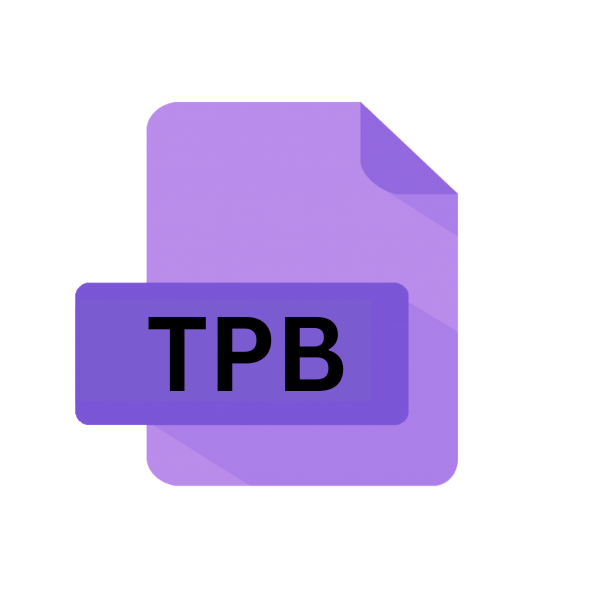.TPB File Extension

GROMACS Binary Input File
| Developer | Gromacs |
| Popularity | |
| Category | Data Files |
| Format | .TPB |
| Cross Platform | Update Soon |
What is an TPB file?
TPB files are binary input files used by GROMACS (GROningen MAchine for Chemical Simulations), a versatile package to perform molecular dynamics, i.e., simulate the Newtonian equations of motion for systems with hundreds to millions of particles.
These files are essential for running simulations, as they contain pre-processed simulation parameters, including the system setup, integrator settings, and other data required by GROMACS to execute a simulation.
More Information.
GROMACS was first released in the early 1990s, with the primary goal of providing a fast, versatile tool for molecular dynamics simulations. The introduction of the TPB file format was a significant advancement, intended to optimize the preparation phase of simulations.
By pre-processing information into a binary format, GROMACS could rapidly read simulation parameters, reducing setup times and facilitating more complex simulations.
Origin Of This File.
The TPB file extension is intrinsically linked to GROMACS, a project that originated in the University of Groningen in the Netherlands. Developed initially for biomolecular simulations, GROMACS has evolved to support a wide range of molecular dynamics work.
The TPB format was designed to streamline simulation setups, allowing users to pre-process input data and configurations, thus enhancing the efficiency of simulations.
File Structure Technical Specification.
TPB files are binary, meaning they are not meant to be read or edited by humans directly. Instead, they are structured to be efficiently processed by computers.
A TPB file contains several key pieces of information about a molecular dynamics simulation, such as the number of particles, the types of interactions between them, simulation time steps, and temperature regulation methods.
This binary structure ensures quick loading times and minimizes file size, an essential feature for large-scale simulations.
How to Convert the File?
To convert a TPB file, primarily used in GROMACS for molecular dynamics simulations, you’ll need to utilize GROMACS command-line tools.
First, ensure GROMACS is installed on your system. Open a terminal (or Command Prompt in Windows) and navigate to the directory containing your TPB file.
Use the gmx editconf command for converting TPB files into more accessible formats like GRO or PDB, which are suitable for visualization and further analysis.
For example, executing gmx editconf -f input.tpb -o output.gro converts the TPB file to a GRO file. This process enables researchers to easily manipulate and analyze simulation data across various platforms.
Advantages And Disadvantages.
The use of TPB files in GROMACS offers several advantages. Primarily, it allows for rapid setup and execution of simulations, saving valuable computational resources.
The binary format also ensures that the files are compact, which is crucial for handling extensive simulations.
The binary nature of TPB files means that they cannot be edited or reviewed easily, requiring specific tools to modify or inspect the simulation parameters.
How to Open TPB?
Open In Windows
- Install GROMACS: First, you need to install GROMACS on your Windows machine. This can be done through the Windows Subsystem for Linux (WSL), Cygwin, or native Windows ports if available.
- Use Command Line: Once GROMACS is installed, open Command Prompt or PowerShell (or the terminal in WSL) and navigate to the directory containing your TPB file.
- Run GROMACS Commands: Use GROMACS command-line tools to open or manipulate the TPB file, such as
gmx dumpto inspect the file orgmx mdrunto run simulations based on the TPB file.
Open In Linux
- Install GROMACS: Use your distribution’s package manager (apt for Ubuntu, yum for Fedora, etc.) to install GROMACS.
- Terminal Access: Open a terminal window and navigate to the folder where your TPB file is located.
- Execute GROMACS Utilities: Utilize GROMACS commands to work with the TPB file, similar to the process described for Windows.
Open In MAC
- Install GROMACS: Install GROMACS on macOS using Homebrew or MacPorts, or compile it from the source.
- Open Terminal: Locate the Terminal app and open it.
- Work with TPB File: Like in Linux and Windows, use GROMACS command-line tools to open or process the TPB file.
Open In Android
Directly opening and manipulating TPB files on Android is not practical due to the operating system’s limitations and the computational requirements for GROMACS. However, you can:
- Use Remote Access Tools: Applications like Termux can provide a Linux environment on Android, but for heavy tasks like GROMACS simulations, consider accessing a remote server or desktop machine that has GROMACS installed via SSH or remote desktop apps.
Open In IOS
iOS, like Android, is not suited for directly handling TPB files for similar reasons. To work with TPB files on iOS:
- Remote Access: Utilize SSH clients or remote desktop applications to connect to a computer or server that has GROMACS installed. This allows you to execute GROMACS commands and manage TPB files indirectly.
Open in Others
For other platforms or environments not directly supported by GROMACS, such as Chrome OS or non-standard operating systems, the approach is generally to use remote access or virtualization:
- Remote Access: Connect to a system that has GROMACS installed via SSH or remote desktop software.
- Virtualization: Use virtual machines or containers (e.g., Docker) that can run Linux or another supported OS, and install GROMACS within that environment.













